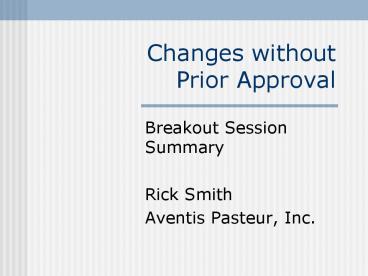Changes without Prior Approval - PowerPoint PPT Presentation
1 / 19
Title:
Changes without Prior Approval
Description:
True risk comes from an assessment of whether product has changed from the ... To bundle or not to bundle. Comparability Protocols. Types of Comparability Protocols: ... – PowerPoint PPT presentation
Number of Views:55
Avg rating:3.0/5.0
Title: Changes without Prior Approval
1
Changes without Prior Approval
- Breakout Session Summary
- Rick Smith
- Aventis Pasteur, Inc.
2
Issues Discussed
- Risk Analysis for Post Approval Changes
- Comparability Protocols
- Development Reports
- Other Risk-Based Approaches and Next Steps
3
Risk Analysis
- Cost / market availability / approvability
- Team approach to risk assessment
- Change control
- True risk comes from an assessment of whether
product has changed from the product used to
generate clinical data - Risk assessment capability is directly related to
process knowledge and product experience
4
Concerns and Suggestions
- Industry wants a decision tree to assess risk
(white paper from industry to FDA) - Dilemma cant afford some changes, cant afford
not to change (keep up with cGMPs) - Harmonization
- Develop a system to identify low risk changes
that were successful to lessen the change
category - To bundle or not to bundle
5
Comparability Protocols
- Types of Comparability Protocols
- General Comparability Protocols
- Product Specific
- Technology Specific
- Single Product
6
Experiences with Comparability Protocols
- Protein drugs wide use
- Chemical drugs lt 10 use
- CVM, GphA no use
- Application
- Single change for multiple products
- Major changes to single product
- Planned changes
- Used during development
7
Advantages with Comparability Protocols
- Implementation timing can be immediate and
consistent - Early FDA input
- Greater assurance of acceptability and
predictability - Increased efficiency for Comparability Protocols
covering multiple products - Helps with changes not covered by SUPAC
- Most useful for complex molecules
8
Problems or Limitations with Comparability
Protocols
- Time required is not always worth the effort
- Uncertainty regarding review time for non-PDUFA
products - Not useful for unplanned changes (due to timing)
- Draft guidance has too many exclusions
- Does require extra submissions unless in original
NDA (Agency and Company)
9
Suggestions for Future
- One CP guidance for all types of products
- Utilize experiences from CPs to expand SUPACs
- Do not try to use CP for large numbers of changes
most of which will not be executed
10
Development Reports Positive Feedback
- Development report needed to explain development
strategy, data and why something was done. - Easier to justify future changes
- Proactively identify critical parameters and
impact of changes on those parameters. - Gives FDA confidence that firms understand
product and process
11
Development Reports Positive Feedback
- Helpful to maintain product history especially if
employees leave the company - Description of full story failures and
successes are valuable - Helpful to have justification why certain tests
are relevant and others not
12
Development ReportsNegative Feedback
- May not be applicable for older products or
generics - Additional work or filing requirement with no
obvious benefit - Goes against goals of filing less or reducing
burden - Sharing failures is a concern
- All development data isnt relevant to commercial
product
13
Development ReportConcerns
- How will FDA use the data?
- Which data should be submitted?
- Will development reports be reviewed by FDA and
found to be deficient thereby holding up
approval? - Would not want to submit data because it may
contain data generated in non GMP lab.
14
Other Risk-Based Approaches
- Develop system to permit less burdensome filing
requirements based on company - Compliance history
- Robustness of quality system
- Quality of filings
15
Specific Recommendations for Opportunities for
Less Burdensome Filing Requirements
- SUPAC Guidances
- Analytical changes
- Packaging
- Sterile Products
- Common / repetitive changes
- Concurrent validation / stability
- Use of decision trees
- Comparability Protocol Templates
16
Other Systems
- European procedure for Type I and Type II
Variations - Re-registration every 5 years
- Canadian system
- Use as learning experience
17
Next Steps
- Need to be more global, not US centric
- Prioritize activities based on FDA and industry
impact - More dialogue with FDA / Industry on development
data
18
Next Steps
- Guidances
- Have industry draft guidance for FDA
- Finalize draft guidances
- Draft more guidances
- Update existing guidances
19
Future Workshops
- Risk assessment of aseptic processing changes
- Development reports value, what is needed, how
used and benefit to industry - Risk management systems and different approaches

